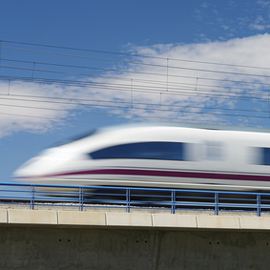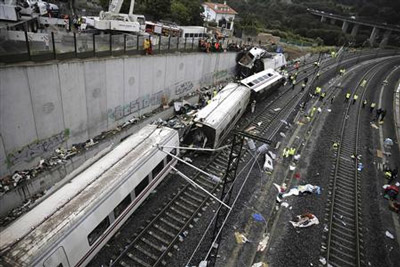Staff responsibility in case rail accidents get further attention
Posted: 12 August 2016 | Peter van der Mark | No comments yet
Regular blogger Peter van der Mark looks at the developments around the Spanish high-speed rail accident in Santiago de Compostela following ERA intervention.


Following a previous article in Global Railway Review about responsibility attributable to key staff in the case of an accident, an interesting and welcome development occurred last October. The European Railway Agency (ERA) expressed concern about the CIAF accident report into the 24-07-2013 high-speed Santiago de Compostela derailment in Spain and asked for a review by an independent body of relevant expertise. The ERA noted that the necessary independence from vested interests in the official Spanish accident report appeared compromised, given that (contrary to European ruling) staff from infrastructure provider, ADIF; train operator, RENFE; and consulting transport engineers, Ineco, were involved in the investigation by the official transport accident investigation body, CIAF. As a result the CIAF investigations and report do not comply with the requirements of European law as expressed in articles 19, 21.1, 21.2 and 22.3 of the Railway Safety Directive. The occurrence of the accident highlighted a lack of essential safety measures, as the driver errors – indicated as the sole reason for the accident – should have been mitigated through intervention by an Automatic Train Protection system before resulting in a fatal high-speed crash. These underlying causes – indicating responsibilities lodged with Ineco, ADIF and RENFE – were not sufficiently explained to enable relevant conclusions to be drawn. Confirming receipt on 8th July 2016, EU Transport Commissioner Violeta Bulc said that the Spanish authorities have taken steps in the right direction.


High-speed derailment at Santiago de Compostela in Spain (Image: Reuters)
This crash is mostly remembered because a trackside camera recorded it and the video was subsequently viewed by millions on television and the Internet. What happened was as follows: After coming off a high-speed line a class 730 Alvia Talgo high-speed electro-diesel set derailed in the A Grandeira curve, near Santiago de Compostela, due to failure to brake from 200km/h to the requisite 80km/h permanent speed restriction. Available ETCS level 2 ATP on the train was switched off as, following their conversion from class 130 electric sets, problems occurred that had yet to be dealt with. Track-side ETCS equipment was not fitted in the curve section, meaning the speeding train on that dangerous location was only supervised by the ASFA classic warning system which advises the permitted speed restrictions but does not intervene. As a result the train fully derailed, hit a concrete retaining wall and came to rest severely damaged whilst on fire at the rear. The toll out of 218 passengers and 4 staff on board was 80 fatalities and 139 injured, after 1 person died in hospital. The CIAF accident report notoriously placed full responsibility for the crash on driver Garzón Amo and legal proceedings were started, despite failure to intervene by an Automatic Train Protection (ATP) system that could have reasonably been expected to be fitted to a modern European high-speed line and the lines directly connected to them. As the train driver has no responsibility for ATP equipment issues, responsibility for this accident must therefore partly rest elsewhere. Interestingly, in this way, the CIAF report inadvertently also drew attention to possible structural train protection safety flaws around the Spanish high-speed rail network, that required urgent attention in the weeks following the accident.
“Responsibility for this accident must therefore partly rest elsewhere”
The ERA notices that, prior to the accident a “leader driver” commented in writing on potential risks emanating from this situation. With a decent risk-analysis signalling, the track lay-out and trainset should not have been considered safe as they were operated, no ATP being available, at a location where an obvious and dangerous overspeed risk existed. Furthermore, the video shows how the diesel-electric generator vehicle behind the front electric power car – added to an existing design to enable use of the trains beyond the electrified network – started the derailment sequence through falling over and dragging the other vehicles out of the track. This indicates that there are inherent issues with the stability of the trainsets and their suitability for the job they are tasked with. This train could arguably have made it through that curve, even speeding as it did, had these diesel generator vehicles not been included in the consist. Additionally, there were no distant speed restriction warning boards and the ASFA indication for the speed restriction ahead came at a moment when the driver was distracted by a phone call which caused him to read through printed matter just before the train entered the curve at high-speed. Internationally, it is now common knowledge that under specific circumstances there is a safety issue connected with phone calls to vehicle operators. For instance, the widely reported Amagasaki derailment catastrophe on 25-05-2005 in Japan, killing 107 and injuring 562 people, was (among other issues) triggered by just such a call, at just the wrong moment, from the traffic control office.
Spain worked hard to become a leading European high-speed rail nation
Spain worked hard to become a leading European high-speed rail nation; in a comparatively short time the country not only created a comprehensive high-speed rail network with a strong unique character and built up a widely respected railway construction industry, but additionally invented and patented a number of practical solutions to specific problems. This particular type of gauge-changing, tilting, hybrid-powered, high-speed and Talgo type of articulated train is, in fact, a travelling catalogue. The nation rightly deserves praise for these achievements.
It is therefore unfortunate that the authorities allowed the railways to step into the trap of obfuscation after the accident – as could be expected; it made them look shifty and incompetent. Instead of publicly blaming just one person they should have given full insight into what happened, to assure all customers that they meant to avoid such an accident from occurring again and knew the means to achieve it. It is not as if CIAF wrote the first rail accident report ever; there were published provisions by the ERA to enable them to do a proper job. Hardly anyone who knows anything about transport will judge a transport operating organisation for being involved in an accident. It is how you deal with it afterwards that makes the difference!








